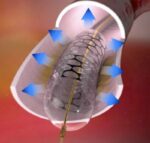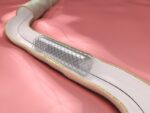Original title: Benefits and Risks of Extended Duration Dual Antiplatelet Therapy after PCI in Patients With and Without Acute Myocardial Infarction. The DAPT Study. Reference: Robert W. Yeh et al. J Am Coll Cardiol. 2015, online before print. The risks and benefits of prolonged antiplatelet therapy after PCI could be different in patients presenting with AMI compared to<a href="https://solaci.org/en/2015/04/21/risks-and-benefits-of-extending-dual-antiplatelet-therapy-in-patients-with-and-without-mi/" title="Read more" >...</a>
PCI with everolimus eluting stent or CABG for multivessel coronary artery disease.
Original title: Everolimus-Eluting Stents or Bypass Surgery for Multivessel Coronary Disease. Reference: Sripal Bangalore, M.D. et al. N Engl J Med. 2015 Mar 26;372(13):1213-22. Coronary artery bypass grafting (CABG) have had better outcomes than percutaneous coronary intervention (PCI) in the treatment of multivessel coronary disease. However, this information comes from studies that do not include new generation stents.<a href="https://solaci.org/en/2015/04/09/pci-with-everolimus-eluting-stent-or-cabg-for-multivessel-coronary-artery-disease/" title="Read more" >...</a>
Is the 2nd generation DES an alternative to surgery in multivessel coronary disease?
The benefits of 2nd generation drug-eluting stents (DES) are being compared with Coronary artery bypass graft surgery (CABG), looking to achieve a safe, effective, less invasive and as complete as possible revascularization. As background of SYNTAX, the stent thrombosis (ST) with Taxus, reached 25% of the events in the group of intervention (PCI), so that<a href="https://solaci.org/en/2015/04/07/is-the-2nd-generation-des-an-alternative-to-surgery-in-multivessel-coronary-disease/" title="Read more" >...</a>
Bioresorbable vascular scaffold vs. the best-in-class DES
Original title: Comparison of everolimus- and biolimus-eluting coronary stents with everolimus-eluting bioresorbable vascular scaffolds. Referencia: Puricel S. et al. J Am Coll Cardiol. 2015 Mar 3;65(8):791-801. The everolimus eluting bioresorbable scaffold (BVS) is effective at treating simple lesions in stable patients but it has yet to be assessed against the best-in-class DES. This study compared BVS performance against<a href="https://solaci.org/en/2015/04/01/bioresorbable-vascular-scaffold-vs-the-best-in-class-des/" title="Read more" >...</a>
Double Anti platelet aggregation would be sufficient for six months after angioplasty in patients with stable coronary disease NSTSEACS.
Original title: 6- Versus 24-Month Dual Antiplatelet Therapy After Implantation of Drug. Reference: Eluting Stents in Patients Nonresistant to Aspirin The Randomized, Multicenter ITALIC Trial. JACC.VOL. 65, NO. 8, 2015 Current recommendations on dual antiplatelet therapy (DAPT) are under review, particularly in acute coronary events due largely to the advent of second-generation stents. This work studied the hypothesis<a href="https://solaci.org/en/2015/03/10/double-anti-platelet-aggregation-would-be-sufficient-for-six-months-after-angioplasty-in-patients-with-stable-coronary-disease-nstseacs/" title="Read more" >...</a>
Zotarolimus eluting stent with one month of dual antiplatelet therapy
Original title: Zotarolimus-Eluting Versus Bare-Metal Stents in Uncertain Drug-Eluting Stent Candidates. Reference: Marco Valgimigli et al. J Am Coll Cardiol. 2015;65(8):805-815. The use of drug eluting stents (DES) in patients at high risk of bleeding or thrombosis has not been studied prospectively. Data on patients at high risk of bleeding and low restenosis are limited. This study compared<a href="https://solaci.org/en/2015/02/25/zotarolimus-eluting-stent-with-one-month-of-dual-antiplatelet-therapy/" title="Read more" >...</a>
The MGuard stent shows a trend toward reduced mortality in PCI
Original title: Mesh-Covered Embolic Protection Stent Implantation in ST-Segment–Elevation Myocardial Infarction. Final 1-Year Clinical and Angiographic Results From the MGUARD for Acute ST Elevation Reperfusion Trial. Reference: DariuszDudek et al. CircCardiovascInterv. 2015 Feb;8(2). The MGuard is a micronet mesh-covered stent designed to reduce distal embolization in the context of ST elevation myocardial infarction. In the MASTER study<a href="https://solaci.org/en/2015/02/23/the-mguard-stent-shows-a-trend-toward-reduced-mortality-in-pci/" title="Read more" >...</a>
Positive result of intraarterial thrombolysis in acute ischemic stroke
Original title: A Randomized Trial of Intraarterial Treatment for Acute Ischemic Stroke. MR CLEAN Investigators. Reference: O.A. Berkhemer et al. N Engl J Med 2015;372:11-20. In patients undergoing acute ischemic stroke caused by a proximal intracranial artery occlusion, intraarterial endovascular treatment is effective; however, there is no evidence of clinical or functional benefits. This study randomized patients undergoing<a href="https://solaci.org/en/2015/02/10/positive-result-of-intraarterial-thrombolysis-in-acute-ischemic-stroke/" title="Read more" >...</a>
OCT useful to assess non ostial left main lesions
Original title: Frecuency domain optical coherente tomography to assess non-ostial left main artery. Reference: Francesco Burzotta, et al. EuroIntervention 2015;10e1-e8 Optical coherence tomography (OCT) has proved valuable in making decisions and monitoring stents implanted in coronary arteries, but its role in the assessment of left main (LM) lesions remains unclear. The study included 54 patients presenting moderate<a href="https://solaci.org/en/2015/02/09/oct-useful-to-assess-non-ostial-left-main-lesions/" title="Read more" >...</a>
Safety and efficacy of DES in saphenous vein bypass graft PCI
Original title: Safety and effectiveness of drug-eluting versus bare-metal stents in saphenous vein bypass graft percutaneous coronary interventions: insights from the Veterans Affairs CART program. Reference: Aggarwal V et al. J Am Coll Cardiol. 2014;64:1825-1836. This study retrospectively evaluated 2471 receiving after saphenous vein graft (SVG) PCI between October and September 2011. Outcomes were compared using propensity<a href="https://solaci.org/en/2015/02/02/safety-and-efficacy-of-des-in-saphenous-vein-bypass-graft-pci/" title="Read more" >...</a>









